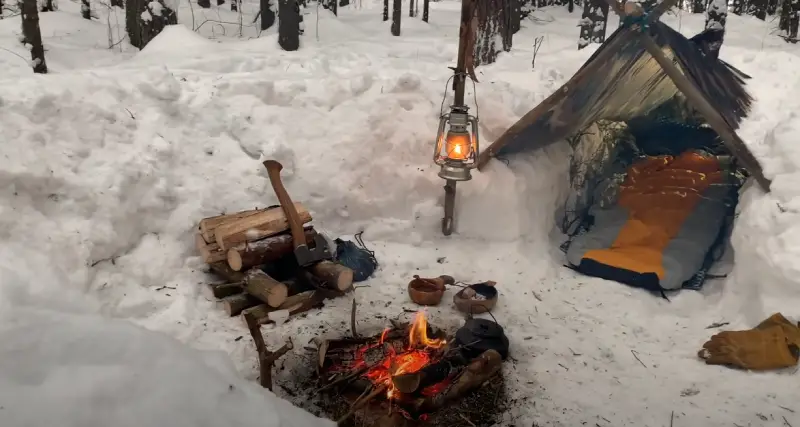Can You Camp Without A Tent: 5 Alternatives Ways [From Experience]
Camp without a tent was an exciting and adventurous experience for me, but it also came with a few risks. Without a tent, I was exposed to elements like rain, wind, and intense heat or cold.
Exposure to these elements led to hypothermia, heat exhaustion, sunstroke, and, sometimes, even death. Insects and animals were also an issue to consider. Without a tent as a barrier, I was more susceptible to insect bites, such as mosquitoes, ticks, and stinging insects.
If you don’t enjoy sleeping in a tent, you can still go camping by choosing from other accommodation options such as cabins and yurts. These alternatives offer more comfortable sleeping arrangements while allowing you to experience the joys of camping.
I will share can you can camp without a tent, some alternatives, ways and cons and cons of a tent without camping.
Can You Camp Without A Tent: 5 Alternatives Ways
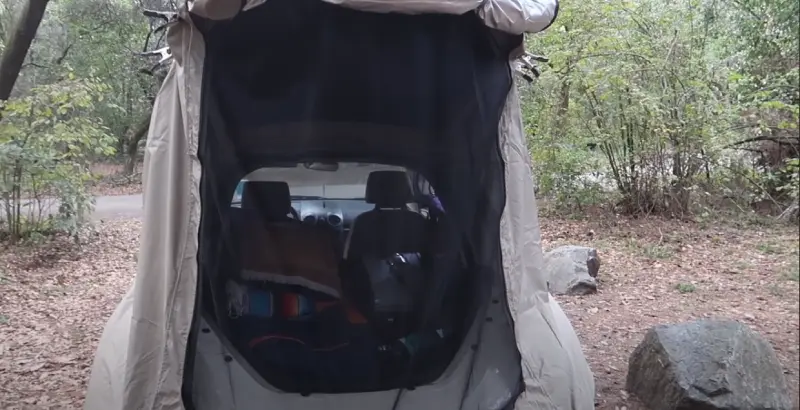
I am always looking for ways to make my outdoor adventures more exciting. That’s why I explored the idea of camping without a tent. And let me tell you, it was quite an experience. I’ll share some helpful tips and tricks for anyone who wants to try camping without a tent.
Cowboy Camping
One of the best things about camping without a tent is sleeping under the stars. This is called cowboy camping, and it’s the most straightforward and cheapest way to camp without a tent. You only need a sleeping bag, a pad, and a clear sky.
I have done cowboy camping a few times, and it was a fantastic experience. I felt closer to nature and enjoyed the night sky’s beauty. I also felt more adventurous and accessible, as I didn’t have to worry about setting up or packing a tent.
Cowboy camping also has some drawbacks. You are exposed to the elements, so you need to check the weather forecast before you go. You must also find a flat, clean spot to sleep in and avoid any areas with snakes, scorpions, or other critters. You must lock your sleeping bag to stay warm and prevent bugs from crawling. Here are some tips for cowboy camping:
- Look for a flat spot to sleep on.
- Clear the area of any rocks, sticks, or other debris.
- A sleeping pad can enhance the comfort and insulation of your sleeping space.
- Keep your sleeping bag zipped up to stay warm.
- When it gets dark, use a headlamp or flashlight.
- Secure your valuables or keep them close to you.
Bivvy Camping
Bivvy camping is another option for camping without a tent. A bivvy bag is a lightweight, waterproof shelter that you can use to keep yourself dry and warm. It’s like a sleeping bag with a hood and a zipper covering your face.
I have not tried bivvy camping, but I have seen some people do it near my campsite. They enjoyed the simplicity and portability of bivvy camping. They also said that bivvy camping is suitable for stealth camping, as it is less visible than a tent.
Bivvy camping also has some drawbacks. You have less space and ventilation than a tent so you might feel claustrophobic or sweaty. You also have less protection from bugs and animals, so you might use a bug net or a bivvy bag with a mesh window. Here are some tips for bivvy camping:
- Invest in a high-quality bivvy bag.
- Choose a place that is protected from the wind and rain.
- For increased comfort and insulation, use a sleeping pad.
- Keep your gear inside the bivvy bag with you.
- Don’t forget to keep your valuables close to you.
Hammock Camping
If you’re looking for a unique camping experience, try hammock camping. Sleeping in a hammock can be incredibly relaxing and peaceful. You can sway gently with the breeze, listen to the sounds of nature, and feel the sun’s warmth.
Most people near my campsite do hammock camping, but I haven’t tried it. They seemed to enjoy the comfort and fun of hammock camping. They also said hammock camping suits uneven or rocky terrain, as it does not require a flat surface.
Hammock camping has drawbacks. You must find two sturdy trees at least 12 feet apart to support your weight. Correctly setting up and adjusting your hammock is crucial to avoid discomfort in your back or neck. Staying warm and dry is essential when exposed to the open air and rain. Here are some tips for hammock camping:
- Choose a sturdy, high-quality hammock.
- Look for trees that are at least 12 feet apart.
- Use a bug net to keep insects away.
- Use a sleeping pad and sleeping bag for added comfort and insulation.
- Use a tarp or a rain fly to protect yourself from the rain.
- At night, use a flashlight or headlamp.
Tarp Camping
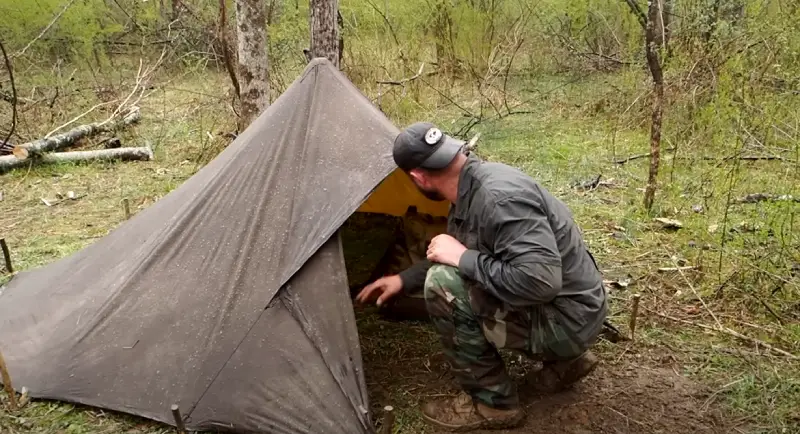
A tarp is a versatile shelter that can be used in many methods. You can create a lean-to, a pyramid, a diamond, or any other shape that suits your needs.
I’ve seen some people do tarp camping near my campsite, but I have yet to try it. They enjoyed the flexibility and creativity of tarp camping. They also said that tarp camping is good for changing weather, as it can be easily adjusted or moved.
Tarp camping also has some drawbacks. You need basic skills and knowledge of knots and rigging techniques, or you might have a flimsy or unstable shelter. You must also find a spot protected from the wind and the rain, or you might get wet or cold. You must keep yourself and your gear off the ground to avoid contact with dirt and moisture. Here are some tips for tarp camping:
- Choose a high-quality, waterproof tarp.
- Learn some basic knots and rigging techniques.
- Look for a protected spot from the wind and rain.
- Insulation and comfort can be enhanced by using mattresses and sleeping bags.
Car Camping
If you have a car, car camping is an excellent alternative to camping with a tent. Take all your gear and supplies with you and enjoy the comfort and convenience of your car. You can sleep in your vehicle or use it as a base camp for other activities.
I have done car camping twice, and it was a comfortable experience. I had plenty of room to sleep and store my gear, and I had access to my car’s features, such as the radio, the heater, and the charger. I also had more security and privacy than camping in a tent.
Car camping also has some drawbacks. You need to find a place where you may park and sleep in your car, or you might get fined or towed. You must also keep your vehicle clean and organized, or you might end up with a mess or an unpleasant smell. And you need to be careful about your car’s battery and gas, or you might end up stranded or stuck. Here are some tips for car camping:
- Choose a spacious car with space to sleep and store gear.
- Invest in a comfortable air mattress or sleeping pad.
- Bring blankets and pillows for added comfort.
- Keep your car clean and organized.
- Crack a window for ventilation.
- Use a sunshade or a curtain for privacy.
- Check your car’s battery and gas before you go.
Sleeping Bag Liner
No matter which method you choose for camping without a tent, a sleeping bag liner can enhance your comfort and warmth. The sleeping bag liner is a thin, soft, breathable fabric that can be inserted within the sleeping bag or used as a standalone sheet. The following are some benefits of using a sleeping bag liner:
- The extra insulation helps keep you warm on chilly nights.
- Dirt and sweat are kept out of your sleeping bag with this product.
- Adds a layer of softness for added comfort.
- It can be easily washed and dried.
Tips for Pet Owners on Tent-Free Camping My Experience
As a pet owner who enjoys the great outdoors, tent-free camping can be thrilling. Planning and preparing for potential situations is essential to ensure a safe and enjoyable experience for you and your furry friend.
Planning and Preparing for Situations
Tent-free camping was exciting, but it was essential to be prepared for any situation that might have arisen. Here are some steps I took:
- Before my trip, I checked the weather forecast to ensure I brought appropriate clothing and gear.
- I brought enough food and water for my pet, including treats and snacks.
- I packed a first aid kit with essentials such as bandages and antiseptics.
- I had a plan in case of an emergency and let someone know where I was going and how long I planned to be gone.
Training My Pet for the Outdoors
Before taking my pet camping, ensuring they were comfortable outdoors was essential. Here’s how I got them ready:
- My pets got used to different terrains and smells by walking or biking in nature.
- To ensure my cat listened to my commands, I practiced obedience training.
- I introduced my cat to other animals they might have encountered on our trip.
Picking a Pet-Friendly Campsite
Choosing a campsite that allowed pets was essential when camping with my furry companion. I kept these things in mind when selecting a campsite:
- It was important to me to find a campground that allowed pets.
- Leash requirements were checked.
- I chose a campsite that offered shade and water for my pet.
- I made sure the campsite was safe.
Keeping My Pets Safe from Wildlife
Encountering wildlife was thrilling, but I had to be careful to keep my pet safe. I took the following precautions:
- I kept my cat on a leash.
- I stored food and trash properly to avoid attracting animals.
- I was aware of the animals in the area and their habits.
- There was a plan if my cat encountered a wild animal.
Cleaning Up After My Pets
Leaving behind waste could harm the environment, so cleaning up after my pet was important. Here’s how I did it:
- I brought poop bags and disposed of waste properly.
- I removed any toys or bedding before leaving the campsite.
- I used eco-friendly cat products when possible.
3 Things to Consider When Camping Without a Tent With My Pets
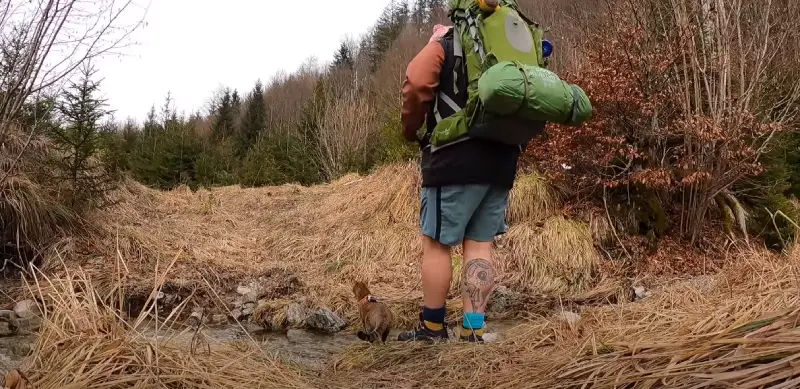
I wanted to see if camping without a tent was possible. It is doable after some research and personal experience, but certain factors must be considered, especially when bringing pets.
Considering My Pet’s Size and Behavior
The first thing I considered before camping without a tent was my pet’s size and behavior. While smaller pets were more accessible to manage, larger ones required more attention and space. My pet’s behavior also affected my camping experience. If my cat was easily spooked or barked at every little noise.
Regulations and Restrictions for Pets
Not all camping locations allowed pets, and even those that did might have had restrictions on where pets could go. I always researched the camping site beforehand and checked for cat regulations and rules. Some campsites required proof of vaccinations and a cat permit.
Ensuring My Pet’s Comfort and Safety
While camping without a tent seemed exciting, ensuring my cat was comfortable and safe during the experience was essential. I confirmed my pet had access to enough food and water and a comfortable place to rest. I was mindful of the weather and planned accordingly. If it was going to rain or be excessively windy, I postponed my camping trip.
Packing Necessary Supplies for Pet Care
Adequately equipped with necessary cat care supplies made all the difference when camping without a tent. Besides the basics like food and water, I considered bringing a first aid kit for me and my pet, a leash and collar, and something for them to sleep on, such as a blanket or bed. It was also essential to bring a waste disposal system, such as bags and a shovel, to clean up after my pet.
Tent without Camping Cons and Cons
I used to believe that camping without a tent was an uncomfortable and risky way to spend a night under the stars. However, after experiencing the freedom, flexibility, and close connection with nature that it offers, I became a fan of tent-free camping. I will share the Cons and Cons Camping without a tent:
Advantages
More Freedom to Roam and Explore
- I didn’t have to set up and dismantle a tent, which saved me time and energy.
- I had more spontaneity and flexibility in choosing a campsite.
- I had a more immersive and authentic nature experience, as I could see, hear, and feel everything around me.
Lighter Packing Load
- I eliminated the weight and bulk of a tent, poles, stakes, and rain fly, which meant I could carry less gear and travel more lightly.
- I could hike farther and faster without being weighed down by a heavy load.
Cheaper than Traditional Camping
- I didn’t require expensive or specialized gear, as I could use a bevy, a tarp, a hammock, or a poncho as a shelter.
- I saved money on campsite fees, as many public lands and wilderness areas allowed free or dispersed camping.
Stay Closer to Nature
- I could fully immerse myself in the environment and experience the elements, the wildlife, and the sounds of nature.
- I had a genuine sense of adventure and discovery, as I never knew what I might encounter or discover during my trip.
Unique and Memorable Experience
- I had a sense of excitement, challenge, and achievement that was hard to replicate in other forms of camping.
- I connected with myself, my companions, and the natural world profoundly and unforgettably.
Disadvantages
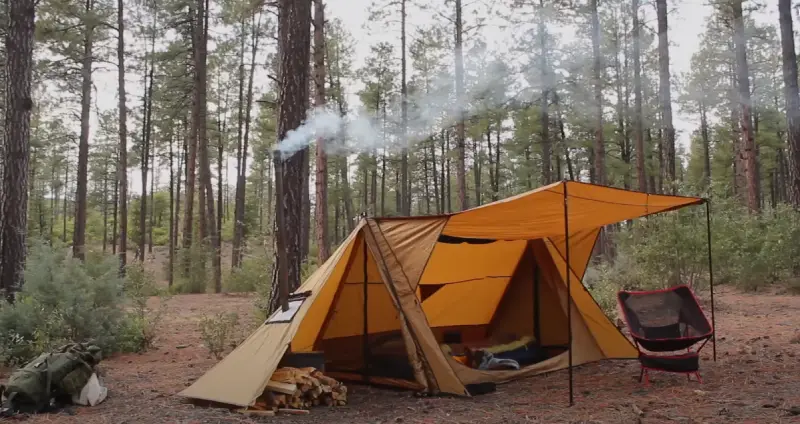
Limited Protection from Weather and Wildlife
- I had little or no protection from rain, wind, cold, or heat, which could make camping uncomfortable or dangerous in
extreme or unpredictable weather. - I was exposed to insects, reptiles, rodents, and other wildlife that posed a risk to my health and safety.
Lack of Privacy and Security
- I didn’t have a separate or enclosed space for sleeping, dressing, or storing my gear, which made me feel exposed, or uncomfortable.
- I attracted unwanted attention from other campers, hikers, or travelers who intruded on my space or belongings.
Necessary Camping Skills and Knowledge
- To ensure my safety, comfort, and sustainability, I needed basic and advanced camping skills, such as site selection, shelter construction, fire building, water treatment, and food storage.
- I needed a good understanding of the local environment, weather patterns, wildlife behavior, and regulations that affected my camping experience.
Requires Special Equipment for Comfort
- I needed specialized gear to make tent-free camping comfortable and safe, such as a high-quality sleeping bag, a warm and waterproof jacket, a bug net, a pad or mat for insulation, and a stove or fuel for cooking.
- I had to do some trial and error to find the right gear and setup that suited my needs and preferences.
Not Ideal for Large Groups
- It was unsuitable for large groups or families, as it was hard to find enough space for everyone’s comfort and safety.
- It required more planning, coordination, and logistics to accommodate multiple people and their gear.
Conclusion
You can have a fun and rewarding camping experience without a tent. You can enjoy the beauty of nature, the freedom of adventure, and the simplicity of living. Not carrying a heavy tent can save money, space, and time.
Camping without a tent also requires some preparation, skills, and knowledge. You must choose the proper method for your needs, budget, and weather. You must also bring the right gear and supplies to stay comfortable, safe, and happy.
![5 Alternatives to Tenting [My Experience]](https://tentgirl.com/wp-content/uploads/2024/05/Can-You-Camp-Without-A-Tent-1.webp)

